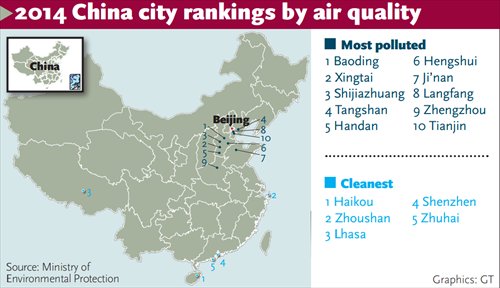

Enforcement of strictest environment laws ‘key to reducing pollution’

Graphics: GT
The average air quality in 74 major Chinese cities improved slightly in 2014, but only eight reached the national standard of annual average pollution density, with another eight in North China's Beijing-Hebei-Tianjin region on the 10 most polluted list, the Ministry of Environmental Protection(MEP) announced Monday.
Among the 10 most polluted cities, seven are in Hebei Province, with Baoding on top. The other three are Ji'nan in Shandong Province, Zhengzhou in Henan Province and Tianjin, a newcomer to the list in 2014, replacing Xi'an, Shaanxi Province.
The 2013 list was the first of its kind in China.
Beijing, which is often besieged by smog, was not on the most polluted list. The MEP data showed that Beijing's average density of PM2.5, airborne particles smaller than 2.5 microns in diameter and a major air pollutant, dropped by 4 percent from the 2013 level. However, the number of "good days" also dropped 1.1 percent to 47.1 percent, or 172 days. Beijing's position on the list was not noted.
The top 10 cities with good air quality cluster in South and East China along the coast, with Haikou in Hainan Province, Zhoushan in Zhejiang Province and Lhasa in the Tibet Autonomous Region ranked the top three, the same as in 2013.
Southern China's Pearl River Delta region recorded better air quality, with nine monitored cities seeing an average of 298 good days last year, far more than the 156 days in the Beijing-Tianjin-Hebei region.
China introduced an Action Plan on Prevention and Control of Air Pollution in September 2013 to provide guidelines to fight air pollution. The concentration levels of breathable suspended particles must fall by at least 10 percent by 2017 from the levels in 2012, the plan stipulates.
After a year of implementation, five more cities reached the national standard of annual average pollution density. The average number of "good days" in the 74 cities increased by 5.5 percent to 66 percent of the year, the MEP stated.
The density of major pollutants and degree of heavy pollution all decreased in various levels last year across the 74 cities, the MEP said, stressing that major problems remain serious.
Under complex pollution sources, including fossil fuel combustion, vehicle emissions and secondary pollution, the 2014 result showed even heavier regional divisions, as the top 10 most polluted cities are all located in or adjacent to the Beijing-Tianjin-Hebei region, Ma Jun, director of the Institute of Public and Environmental Affairs, told the Global Times.
"It means that emissions reduction must be further strengthened, particularly for Tianjin and Hebei as they have large industrial discharges, while Hebei's geography means the conditions to disperse pollutants are unfavorable," said Ma.
However, making headway in pollution reduction has proven difficult. Yang Chongyong, the vice-governor of Hebei, said in November that the country's major steel production base has entered the "worst economic predicament in 20 years" at the cost of controlling grave air pollution.
But China's central authorities have decided that it must be addressed through industrial restructuring, regional cooperation, pollution source control and other measures laid out in the action plan, as the balanced development of the economy and environment has been prioritized.
With key policies in place and proven effective, the future focus is not on issuing more measures, but on the rule of law as the strictest ever Environmental Protection Law has taken effect this year, to normalize enforcement, said Ma.
The "controlling campaigns" that brought blue skies in Beijing during the Asia-Pacific Economic Cooperation summit in November have to be abandoned, Ma noted.
 PLA soldiers operating vehicle-mounted guns in drill
PLA soldiers operating vehicle-mounted guns in drill Beauties dancing on the rings
Beauties dancing on the rings Blind carpenter in E China's Jiangxi
Blind carpenter in E China's Jiangxi Top 10 highest-paid sports teams in the world
Top 10 highest-paid sports teams in the world In photos: China's WZ-10 armed helicopters
In photos: China's WZ-10 armed helicopters UFO spotted in several places in China
UFO spotted in several places in China Certificates of land title of Qing Dynasty and Republic of China
Certificates of land title of Qing Dynasty and Republic of China  Cute young Taoist priest in Beijing
Cute young Taoist priest in Beijing New film brings Doraemon's life story to China in 3D
New film brings Doraemon's life story to China in 3D China-S.Korea FTA sets positive precedent
China-S.Korea FTA sets positive precedent Ferry carrying 458 people sinks in Yangtze River
Ferry carrying 458 people sinks in Yangtze River Mecca of Marxism
Mecca of Marxism Bring them home
Bring them homeDay|Week